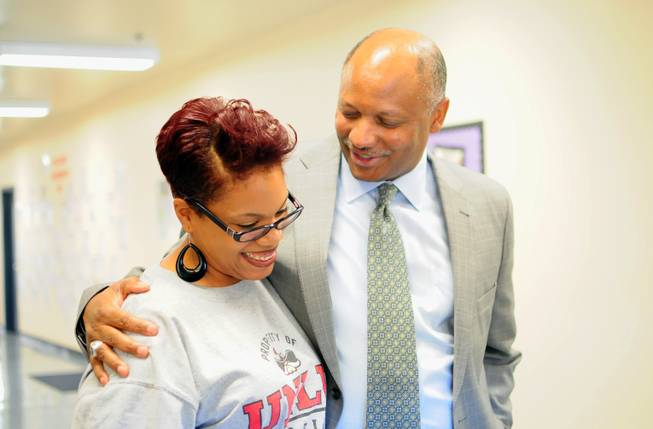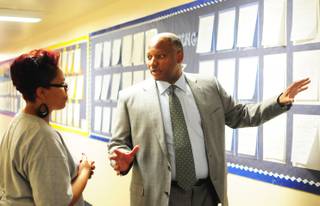
Clark County Schools Superintendent Dwight Jones hugs Principal Amber Brookins at Jacobson Elementary School on Wednesday, Oct. 12, 2011. Jones said he hopes to take formal, one-hour tours at more than 50 schools by the end of the school year.
Sunday, Oct. 16, 2011 | 2 a.m.
Sun Topics
This is another in a yearlong series of stories tracking Clark County School District's efforts to turn around five failing schools.
For a superintendent who oversees the nation’s fifth largest school district, just visiting each of its 357 schools is a massive undertaking.
Since taking the helm of the Clark County School District 10 months ago, Superintendent Dwight Jones has taken formal tours of 40 schools, spending about an hour at each one chatting with principals, teachers, secretaries and custodians.
If Jones took one-hour tours nonstop of all the Clark County schools, it would take him more than two weeks to complete.
Granted, touring 40 schools in 10 months doesn’t seem like a lot. It’s just over 10 percent of all the schools Jones oversees.
But take into account the three summer months schools weren’t in session. Add the fact Jones is a new superintendent trying to fix a school system that graduates only half of its seniors. Pile on the meetings, paperwork and management duties, and the task of visiting every school becomes a tough act to juggle.
Still, it’s a goal that Jones said he embraces. Having direct conversations with the “people in the trenches doing the work” has been invaluable, he said, in helping him shape new school policies.
“I haven’t taught any kids in my office in a long time, so I’ve got to get out to where the action is,” he said. “We want people to know we’re paying attention and we care.”
•••
One recent morning, Jones visited Victoria Fertitta Middle School and Walter Jacobson Elementary School in the northwest valley. Jones — wearing a gray suit and tie — spent the much of the morning walking the hallways and stepping into classrooms at the two schools.
Jones is greeted by first-year Principal Lisa Burkhead, who will lead the tour at Fertitta. Joining Jones is School Board President Carolyn Edwards, who represents the 1,400-student school located near Mesa Vista Avenue and Grand Canyon Drive.
The group makes its way down the brightly lit hallways, popping into several classrooms. Jones observes a sixth-grade math class learning about least common multiples from a first-year teacher. Nodding and smiling, Jones remarks to Burkhead, “That’s a pretty calm class. The teacher is really engaging.”
The bell rings and students pour out into the hallways. Towering over the students, Jones greets some and asks, “Any Cowboys fans in this group?” (Although Jones grew up in Kansas, he’s grown an affinity for the Dallas football team and sports a big Cowboys ring on his right hand.)
“I am,” a girl says, waving her hand.
Jones breaks out into a huge smile and tells the group, “I love the Cowboys.” He wishes the students good luck with the new school year and ambles to a classroom doorway.
“How big are your classes running?” he asks a teacher observing the interaction. It’s big, she tells him — 35 students. Jones nods. He looks concerned.
“We’ve been trying to move achievement up and when you have class sizes that are 30 or more, that just puts a lot more burden on the teacher,” he tells Burkhead when classes resume. “I want to let the teachers know we’re paying attention to it.”
Into another classroom he goes. This one’s on science, and the students are being quizzed on the electromagnetic spectrum. “Wow, did you get any of the answers?” Jones asks Edwards after they leave the room. “These kids are really smart.”
In the next room, an orchestra class performs a medley. Taking the podium for a moment, Jones tries his hand at conducting. “Boy, it’s really impressive,” he tells them after they finish the song. “Thank you for that rendition. Great job everyone.”
Burkhead leads Jones over to the library. A former librarian, Jones shakes hands with the librarian and tells her, “I really respect what you do. We’re really happy to have you.”
Students, staff and teachers seemed to respond well to the words of encouragement, which come at a time when the School District has made tough decisions on staffing and funding. More is expected of educators with fewer resources, Jones says, acknowledging that can be very challenging for teacher morale.
“We’ve got to figure out how we support teachers in the right kind of way,” he says.
•••
At Jacobson Elementary School a few miles away, another first-year principal, Amber Brookins, leads Jones and School Board member John Cole through the hallways. The walls are lined with colorful student art and class work.
Jones points to one of the walls and suggests to Brookins that teachers keep posting student work throughout the year, layering them on top of one another so that by the end of the year, parents and teachers can see how a student has progressed.
That’s a big selling point for Jones, who, along with Gov. Brian Sandoval, has implemented the growth model, a new measure of student achievement that focuses on how much students have learned over the year. By shifting the focus from standardized test scores to student growth and progress, Jones said, he hopes teachers will feel acknowledged for their efforts to raise student achievement, even if they fail to make proficiency on tests.
Earlier in the week, the School District began training teachers on how to use data from the growth model to tailor their instruction. It’s more about improving students and less about teaching to the test, Jones said.
“Teachers are beginning to get it and recognize the power (the growth model) has,” he said. “The expectations in this district are set too low. The kids are a lot smarter than we give them credit for.”
Jones joins a fourth-grade class. The veteran teacher remarks that his presence means a great deal to her; it’s the first time a superintendent has visited her classroom in more than 20 years.
As Jones walks into an empty computer lab at Jacobson, he’s hit with a wall of hot air. The air conditioning needs to be fixed, Brookins says.
Again, Jones sounds concerned. He wonders aloud how students can concentrate on their schoolwork and computerized tests if the room is overheated.
After the formal tour ends, Jones speaks privately with Brookins for about 15 minutes. Jacobson lost some federal funding this year, so it can’t offer after-school tutoring, Brookins tells Jones. She’s looking for ways to boost student performance with less money, she said.
“Let me know what you need, and I’ll follow up,” Jones tells Brookins.
Jones sighs as he exits the school. He plans to visit 50 more schools by the end of this school year. It’s a daunting task, but it’s worth it, he says. Jones wants to hear about his schools’ triumphs and challenges and hear educators’ concerns, face to face.
“You have to know, whether it’s the good, the bad or the ugly,” Jones says. “And I can’t know sitting in my office.
“I’ve got to get out and about.”



Join the Discussion:
Check this out for a full explanation of our conversion to the LiveFyre commenting system and instructions on how to sign up for an account.
Full comments policy